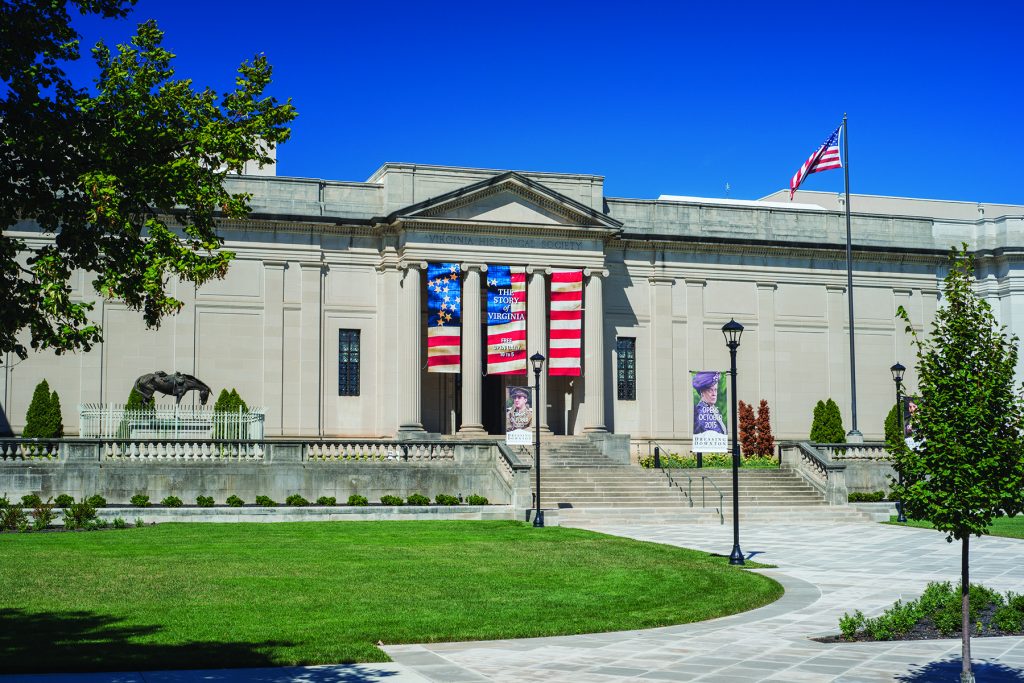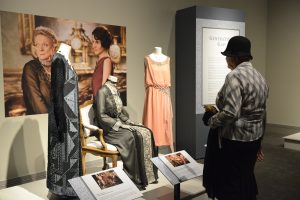
The Virginia Historical Society revamped its Boulevard-facing entrance. Photo by Mark Mitchell Photography.
Almost five years after launching an eight-figure capital campaign, the Virginia Historical Society has soared past its goal.
The museum and library, located at 428 N. Boulevard, expects to have raised $45 million for its Story of Virginia Capital Campaign by the end of the month, exceeding its original goal by about $7 million.
Paul Levengood, VHS’s president and chief executive, said the organization surpassed its $38 million objective in December. Donations came from a mix of private individuals and foundations, along with a couple of government entities and corporations; but private donations made up the bulk of the money, he said.
“It all came down to having a very devoted circle of supporters and friends, not just in Richmond but all across Virginia and in some cases all across the country,” Levengood said. “It really, in the end, comes down to relationships and being able to frame your ideas in a way that does spark something in people’s imaginations.”
About $20 million of the funds is earmarked for capital projects, which Levengood characterized as those with long-term staying power, including recent renovations to the organization’s 200,000-square-foot building and new exhibits.
Construction included adding 4,000 square feet of exhibition space, adding a new entrance to the side of the building facing the Virginia Museum of Fine Arts, creating a multi-purpose learning center, renovating all the galleries and upgrading the Boulevard entrance.

The museum’s “Dressing Downton: Changing Fashion for Changing Times” exhibit, focused on the costumes in the show “Downton Abbey” began in October and ends this weekend. Photo by Meg M. Eastman.
“(We did) everything from adding big, splashy spaces to the behind-the-scenes stuff, like heating and cooling and humidity control that you don’t necessarily notice right away but are very important for what we do,” Levengood said.
While parts of the building remained open during the renovations, the galleries were closed for about 18 months through the beginning of 2014 until this past summer and fall. Whiting-Turner Contracting Co. was the general contractor, and Glave & Holmes Architecture designed the changes.
Levengood said VHS has been encouraging people to “get to know” the facility since reopening.
“You may think you know us, but you may be in for some pleasant surprises if you stop by,” he said.
Additional money went to an endowment of three new education funds, conservation projects and creating new exhibitions. Levengood said many of the donations collected after the VHS reached its goal were already earmarked for specific projects.
The organization received grants from federal agencies including the National Endowment for the Humanities, National Endowment for the Arts, National Park Service, National Historical Publications and Records Commission, and the Library of Congress.
Private foundations that donated included: The Robert G. Cabell III and Maude Morgan Cabell Foundation; The Mary Morton Parsons Foundation; the Elis Olsson Memorial Foundation; the Camp Family Foundations; the E. Rhodes and Leona B. Carpenter Foundation; the Lettie Pate Evans Foundation; the Richard S. Reynolds Foundation; the Roller-Bottimore Foundation; The Richard Gwathmey and Caroline T. Gwathmey Memorial Trust; the Marietta McNeill Morgan & Samuel Tate Morgan, Jr. Foundation; and the Windsor Foundation.
VHS is continuing to accept contributions, with the campaign remaining open until the end of January. It will also collect more donations for its new Virginia Civil War Research Center, which it is in the process of establishing through its partnership with the American Civil War Museum.
Founded in 1831, the VHS’s most recent tax documents show it drew in $14.5 million in revenue in 2013 and had about $6.5 million in expenses, according to Guidestar.com.

The Virginia Historical Society revamped its Boulevard-facing entrance. Photo by Mark Mitchell Photography.
Almost five years after launching an eight-figure capital campaign, the Virginia Historical Society has soared past its goal.
The museum and library, located at 428 N. Boulevard, expects to have raised $45 million for its Story of Virginia Capital Campaign by the end of the month, exceeding its original goal by about $7 million.
Paul Levengood, VHS’s president and chief executive, said the organization surpassed its $38 million objective in December. Donations came from a mix of private individuals and foundations, along with a couple of government entities and corporations; but private donations made up the bulk of the money, he said.
“It all came down to having a very devoted circle of supporters and friends, not just in Richmond but all across Virginia and in some cases all across the country,” Levengood said. “It really, in the end, comes down to relationships and being able to frame your ideas in a way that does spark something in people’s imaginations.”
About $20 million of the funds is earmarked for capital projects, which Levengood characterized as those with long-term staying power, including recent renovations to the organization’s 200,000-square-foot building and new exhibits.
Construction included adding 4,000 square feet of exhibition space, adding a new entrance to the side of the building facing the Virginia Museum of Fine Arts, creating a multi-purpose learning center, renovating all the galleries and upgrading the Boulevard entrance.

The museum’s “Dressing Downton: Changing Fashion for Changing Times” exhibit, focused on the costumes in the show “Downton Abbey” began in October and ends this weekend. Photo by Meg M. Eastman.
“(We did) everything from adding big, splashy spaces to the behind-the-scenes stuff, like heating and cooling and humidity control that you don’t necessarily notice right away but are very important for what we do,” Levengood said.
While parts of the building remained open during the renovations, the galleries were closed for about 18 months through the beginning of 2014 until this past summer and fall. Whiting-Turner Contracting Co. was the general contractor, and Glave & Holmes Architecture designed the changes.
Levengood said VHS has been encouraging people to “get to know” the facility since reopening.
“You may think you know us, but you may be in for some pleasant surprises if you stop by,” he said.
Additional money went to an endowment of three new education funds, conservation projects and creating new exhibitions. Levengood said many of the donations collected after the VHS reached its goal were already earmarked for specific projects.
The organization received grants from federal agencies including the National Endowment for the Humanities, National Endowment for the Arts, National Park Service, National Historical Publications and Records Commission, and the Library of Congress.
Private foundations that donated included: The Robert G. Cabell III and Maude Morgan Cabell Foundation; The Mary Morton Parsons Foundation; the Elis Olsson Memorial Foundation; the Camp Family Foundations; the E. Rhodes and Leona B. Carpenter Foundation; the Lettie Pate Evans Foundation; the Richard S. Reynolds Foundation; the Roller-Bottimore Foundation; The Richard Gwathmey and Caroline T. Gwathmey Memorial Trust; the Marietta McNeill Morgan & Samuel Tate Morgan, Jr. Foundation; and the Windsor Foundation.
VHS is continuing to accept contributions, with the campaign remaining open until the end of January. It will also collect more donations for its new Virginia Civil War Research Center, which it is in the process of establishing through its partnership with the American Civil War Museum.
Founded in 1831, the VHS’s most recent tax documents show it drew in $14.5 million in revenue in 2013 and had about $6.5 million in expenses, according to Guidestar.com.


